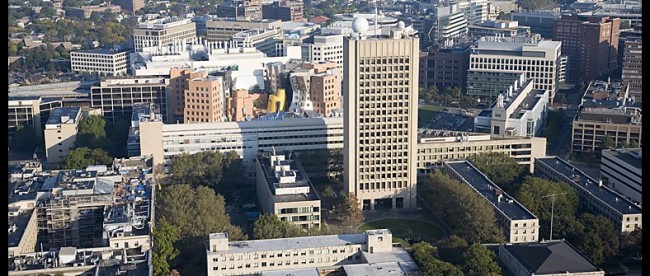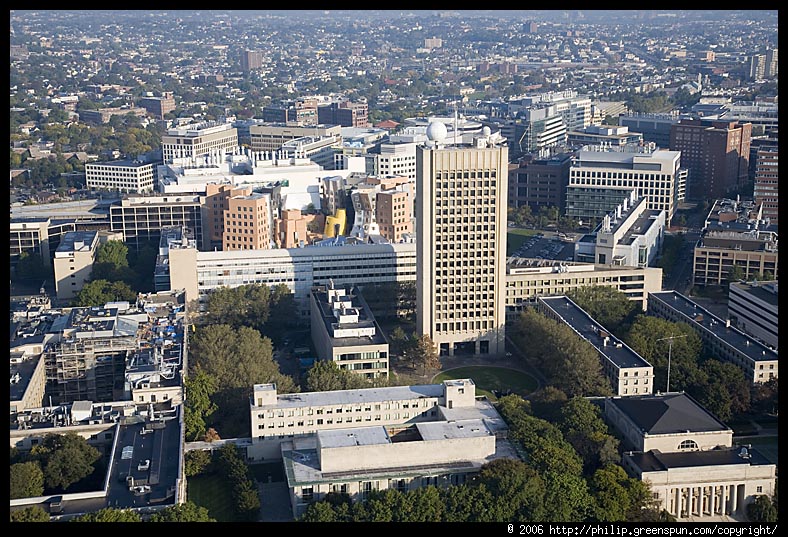The Curious Problem with MIT’s Tallest Building


The tall building in the picture above (larger version here) is the Green Building, situated on the campus of the Massachusetts Institute of Technology, better known as MIT. Built in the early 1960s, the building is named after, Cecil Howard Green, the co-founder of Texas Instruments and a graduate of MIT — he donated much of the money for its construction. One of its principal architects was I.M. Pei, an MIT grad as well, and perhaps the most recognizable name in the modern architecture world. The Green Building is the tallest in Cambridge, Massachusetts, a goal achieved via some creativity. At the time, according to Wikipedia, a Cambridge ordinance limited the number of floors that any given building could have, but didn’t include inhabited first floors (e.g. lobbies) in the floor count. So to make the Green Building higher than all of its neighbors, the MIT team placed it on stilts, with the first floor (excluding some lobbies) starting 30 feet above ground. The Green Building’s record height is a testament to the genius that is common at MIT.
And it’s also a testament to the fact that even geniuses can make mistakes.
The Green Building is located in the middle of a rectangular collection of buildings, as seen in the image above. It is to the north-northwest of the Charles River, with a large, relatively open area in front of it. It’s not uncommon to get a nice breeze off the Charles, which can be a pleasant refresher for those studying hard. But at times, the wind would become overwhelming. Because of the arrangement of the buildings in the area around the Green Building, the wind would gather, gaining speed and intensity, creating a wind tunnel in front of Cambridge’s tallest tower.
Unfortunately, that’s when the lofted first floor turned into a pretty big problem. A former senior vice president of MIT, William R. Dickson, went into detail (pdf) in an interview for an oral history project:
The ground floor [of the Green Building] was open except for the lobbies, which were small, at either end. One is an elevator lobby, and as I said, the other is a lobby for the lecture hall where people could go and wait and then walk up to the lecture hall which was the floor above. The problem was that with the other buildings around, the wind would pile up on the face of the Green Building and then in order to relieve itself would either go around the ends or drop down the face of the building and whip through the opening end of the building. And that was the troublesome point because sometimes people had trouble even walking to the doors under the building because the wind was so bad.
The Boston Wind Tunnels section of the MIT Museum suggests the problem was even worse than Mr. Dickson suggests, stating that “whenever it was windy, it was nearly impossible for pedestrians to enter or exit the building.”
If you go to the Green Building today, and it’s windy enough, you’ll feel the problem — MIT didn’t reorganize its buildings to prevent the wind tunnel from forming. However, you’ll be able to get inside the building, even on the windiest of days. MIT has a system of underground corridors which connect many of the buildings, including the Green Building. (Here’s a pdf map; the Green Building is number 54.) So until a ground-level solution could be found, students and faculty availed themselves of this alternative. Later, the school added revolving doors, which were less susceptible to the wind. So if you visit it today, you may feel the breeze, but you’ll be able to get to your lecture.
Bonus Fact: MIT is a prank-friendly environment, with many elaborate practical jokes more common than you’d think. (The MIT community calls them “hacks.”) The Green Building was the center of one in 2012, when students converted the windows into a playable version of Tetris. The windows were each one pixel, collectively comprising a 9×17 grid with a pedestal-sized controller at the base of the building. You can see Green Building Tetris in action on YouTube, here, and photos of the hack are available at the previous link.
From the Archives: Tetris Therapy: Tetris can help treat PTSD.
Take the Quiz: Name the tallest buildings in each of these cities.
Related: A wind tunnel of your very own.
Top photo courtesy Philip Greenspun.
